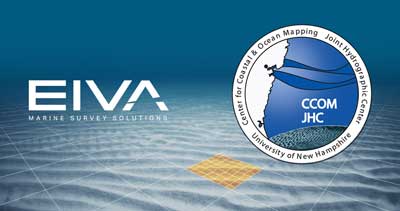EIVA Adds CUBE and GeoCoder to NaviSuite

The University of New Hampshire (UNH) Center for Coastal and Ocean Mapping (CCOM) and EIVA announces that EIVA is now an official industrial partner of CCOM. With this partnership, EIVA is able to implement CCOM’s tools in the new generations of the NaviSuite software products, and UNH students and staff get free use of NaviSuite.
CCOM is one of the cornerstones in the hydrographic community for its research and development activities. One of its objectives is to develop tools to advance ocean mapping and hydrography. Initially, two of these are to be implemented in the EIVA NaviSuite software dedicated to offshore and shallow water survey and engineering operations.
‘This partnership proves EIVA’s commitment to creating an advanced and future-proof software suite for data acquisition and processing for the hydrographic industry as well as the other industries our customers operate in,’ said EIVA CEO Jeppe Nielsen.
One tool to be implemented is CUBE (Combined Uncertainty and Bathymetric Estimator), CCOM’s unique sonar bathymetric data processing algorithm. CUBE was originally verified for hydrographic use in 2003 and has since been adopted by several hydrographic organisations as the de facto processing approach. The second is GeoCoder, another well-known package from CCOM used for processing of backscatter data.
Merging the latest generations of all the software in play
Dr Brian Calder at CCOM heads the development of the next generation of CUBE, known as CUBE V2 or CHRT. The focus is on quality, multi-resolution models as well as parallel processing of the algorithm for higher performance. While CHRT carries out the same basic tasks as CUBE, CHRT is implemented in a more memory- and CPU-efficient manner, designed to be activated from the GUI.
‘CHRT was designed based on the lessons we learned with CUBE, keeping some of the same technology, but making the system data-adaptive, much more efficient, and easier for users to set up. Something that’s very important to us is to make sure that the user gets the algorithm we intended, and can see that this is the case. Working closely with vendors like EIVA is the only way to ensure that, and we look forward to a detailed engagement with them as the implementation moves forward,’ said Dr Brian Calder.
It is CHRT that will be implemented in NaviSuite alongside EIVA’s other processing and cleaning approaches, such as S-CAN, which will of course be kept and maintained as well.
Moreover, CCOM is currently developing a new generation of its GeoCoder solution, named ARES. It is ARES, which EIVA will implement in the NaviSuite products. ARES is still under development, as a parallel process to the development of the next NaviSuite versions. Consequently, as soon as ARES is released, it will be available via NaviSuite.
The implementation of CHRT and ARES has been added to the EIVA 2016 roadmap, which also includes the launch of the fourth generations of NaviModel and NaviPac. This will be covered in more detail at the EIVA Days Denmark 2016 and an EIVA workshop at HYDRO 2016 in Germany.
Introducing the future workforce to NaviSuite
As part of the agreement, CCOM gets free use of NaviSuite for educational purposes for UNH students, researchers and teachers.

